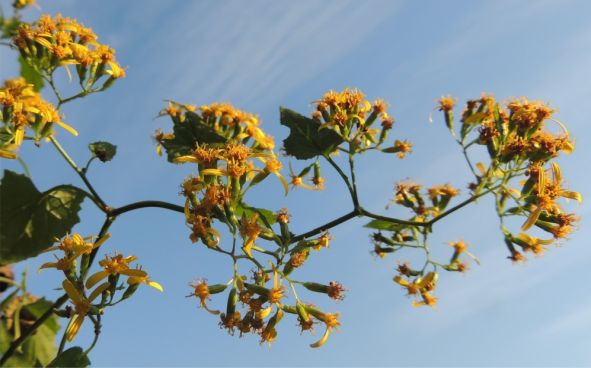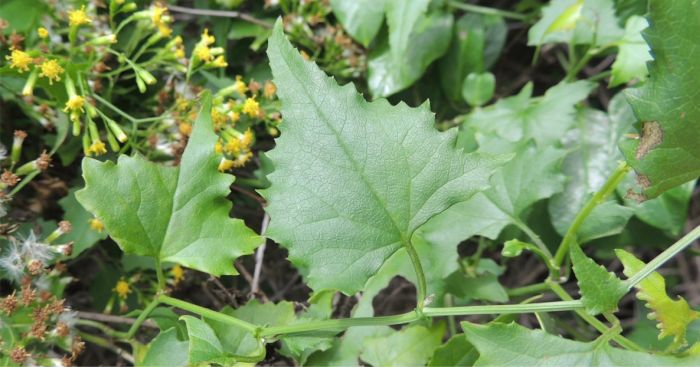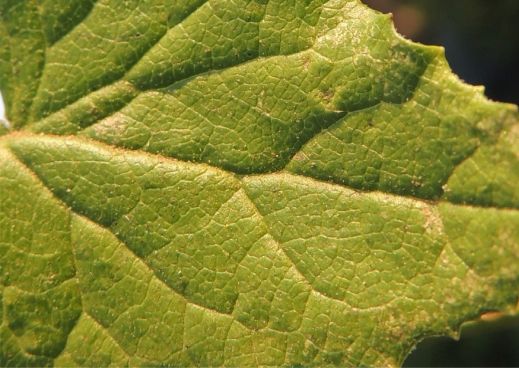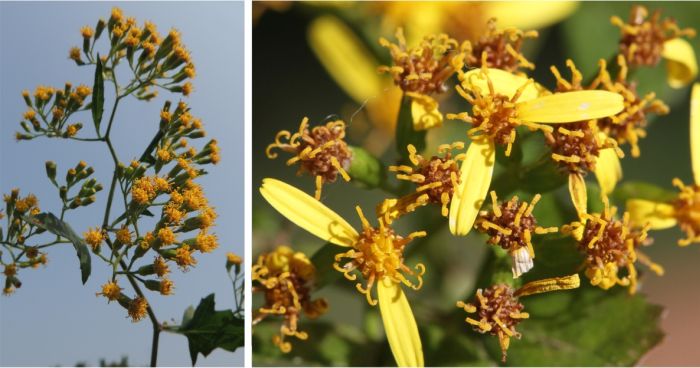Senecio deltoideus
Senecio deltoideus Less.
Family: Asteraceae
Common names: zigzag canary creeper (Eng.); sigsag-kanarieklimop (Afr.); undenze (isiXhosa)
Introduction
Senecio deltoideus is a vigorous creeper producing spectacular displays of sweet-scented bright yellow flowers in early winter. Flowers produce copious nectar to attract insects. It is distinguished by the long-pointed triangular leaf shape and the zigzag branching pattern of the stems, that is particularly obvious in young growth.

Description
Description
Senecio deltoideus is a soft-leaved perennial climbing herb with zigzag branching. It forms a tangled mass, covering other vegetation. Stems are generally smooth but may be sparsely and thinly hairy in some specimens. Leaves are broadly spear-shaped to narrowly triangular, up to 100 mm long and 50 mm wide, but often much smaller, generally without hairs, or the lower surface with thin hairs. Leaf margins are irregularly toothed. Flower heads are grouped in small or large clusters and can be with or without ray florets. Flower heads generally have 1-4 ray florets when present. Both ray and disc florets are bright yellow. Florets are strongly honey scented. Flowering time is in winter, from May to July.

Conservation Status
Status
Senecio deltoideus is listed as Least Concern (LC) in the Red List of South African plants.

Distribution and habitat
Distribution description
Senecio deltoideus is native to southern and eastern Africa. Within South Africa it is found in Western Cape, Eastern Cape, KwaZulu-Natal, Mpumalanga and Limpopo. Further east and north it is found in Lesotho, Eswatini, Mozambique, Zimbabwe, Kenya, Tanzania and Malawi. In its native range the species is generally found in rocky areas within montane grassland, ecotones between forest and grassland, riparian zones, and also along roadsides in high rainfall areas.
It was introduced as an ornamental in the Mediterranean at the beginning of the 19th century. Nowadays the species is a casual neophyte in southeastern France and Spain and has become invasive in northwestern Italy.

Derivation of name and historical aspects
History
Although Senecio deltoideus cannot easily be confused with other species, it shares a similar habitat and growth form with Senecio tamoides (canary creeper) and some forms of S. angulatus. Senecio deltoideus is distinguished by its non-fleshy deltoid leaves and zigzag branching, while both the other species have semi-succulent smooth leaves that are not distinctly deltoid.

Ecology
Ecology
Senecio deltoideus seeds can drop to the ground and re-establish while some seeds can be blown away by wind, or the stems can root where they touch the ground. The strongly honey-scented flowers attract butterflies, bees and other insects.
Uses
Use
Senecio deltoideus is planted by landscapers as ornamentals in resorts and gardens to attract insects, or in hedges.
Senecio deltoideus is used to treat gynaecological and obstetric disorders in combination with Ranunculus multifidus. A handful of chopped Ranunculus multifidus plant or leaves are mixed with leaves of Senecio deltoideus and boiled in 1.5 litres of water for approximately 30 minutes, and then cooled before straining. One cup of the decoction is taken orally three times a day to treat infertility, to cleanse blood when pregnant and to ease labour.
Senecio deltoideus is also used in combination with Senecio serratuloides to treat infertility and for the treatment of respiratory infections. A handful of fresh chopped Senecio deltoideus leaves are mixed with the same amount of Senecio serratuloides. The mixed plant material is boiled in 1.5 litres of water for approximately 30 minutes and strained when it cools down. One cup of the decoction is taken three times a day to treat infertility. For respiratory infections the mixed plant material is boiled with 1 litre of water and drunk half a cup twice a day to treat chest pain, cough, fever, and a runny nose. Children only take 1 tablespoon twice a day. Other uses of Senecio deltoideus reported were for the treatment of sore eyes.

Growing Senecio deltoideus
Grow
Seeds of Senecio deltoideus are sold online, but it can also be propagated by division or stem cuttings in Spring. Keep it out of direct sunlight and water regularly.
Senecio deltoideus grows slowly and doesn’t require added fertilizer. Use any potting soil with ample nutrients. Repot a plant after it doubles in size or once a year to replenish its nutrients. Once established, a plant needs ample sunlight and may drop its leaves when planted in the shade.
Be careful to not over-water plants and use potting soil that drains very well and doesn’t retain too much moisture. Due to the vigorous growth of mature plants, it can get out of hand or take over small spaces but can tolerate pruning.
References
- Casabio, the home of biodiversity, species Senecio deltoideus. https://casabio.org/taxa/senecio-deltoideus. Accessed 2023/07/04.
- De Wet, H. & Ngubane, S.C. 2014. Traditional herbal remedies used by women in a rural community in northern Maputaland (South Africa) for the treatment of gynaecology and obstetric complaints, South African Journal of Botany 94: 129-139.
- Greg, Senecio deltoideus. https://greg.app/plant-care/senecio-deltoideus. Accessed on 2023/05/15.
- Hyde, M.A., Wursten, B.T., Ballings, P. & Coates Palgrave, M. 2023. Flora of Zimbabwe: Senecio deltoideus Less. https://www.zimbabweflora.co.zw/speciesdata/species.php?species_id=161140. Accessed 2023/05/15.
- Minuto, L., Casazza, G., Dagnino, D., Guerrina, M., Macrì, C. & Mariotti, M. 2021. Management of an invasive plant in a Mediterranean protected area: The experience of Senecio deltoideus in Italy. Annali Di Botanica 11: 1–12.
- Raimondo, D., Von Staden, L., Foden, W., Victor, J.E., Helme, N.A., Turner, R.C., Kamundi, D.A. & Manyama, P.A. (eds) 2009. Red list of South African plants. Strelitzia 25. South African National Biodiversity Institute, Pretoria.
- Steenbok Nature Reserve, Senecio deltoideus. https://www.steenboknaturereserve.org.za/flora/plants/senecio-deltoideus/. Accessed on 2023/02/27.
- WFO The World Flora Online, Senecio deltoideus Less. http://www.worldfloraonline.org/taxon/wfo-0000081276#C. Accessed on 2023/05/15.
- Wikiwand, Senecio deltoideus. https://www.wikiwand.com/en/Senecio_deltoideus#References. Accessed on 2023/05/15.
- York, T., De Wet, H. & Van Vuuren, S.F. 2011. Plants used for treating respiratory infections in rural Maputaland, KwaZulu-Natal, South Africa. Journal of Ethnopharmacology 135(3): 696-710.
Credits
Katlego Molele & Marinda Koekemoer
National Herbarium, Pretoria
August 2023
Images by M. Koekemoer.
Map generated by Hester Steyn.
Plant Attributes:
Plant Type: Climber, Scrambler, Shrub
SA Distribution: Eastern Cape, KwaZulu-Natal, Limpopo, Mpumalanga, Western Cape
Soil type: Sandy, Clay, Loam
Flowering season: Autumn, Winter
PH:
Flower colour: Yellow
Aspect: Full Sun
Gardening skill: Easy
Special Features:
Horticultural zones










Rate this article
Article well written and informative
Rate this plant
Is this an interesting plant?
Login to add your Comment
Back to topNot registered yet? Click here to register.